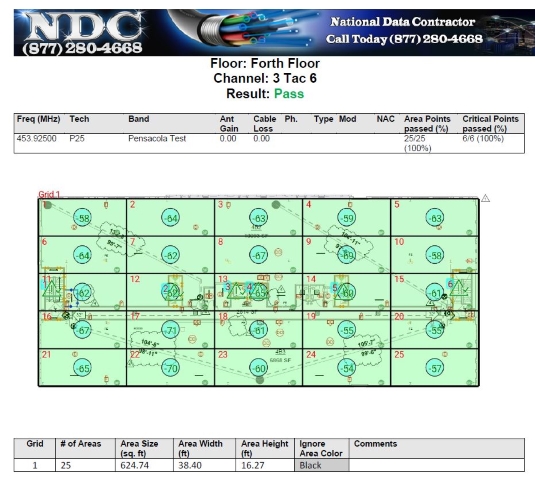ERCES BDA ACCEPTANCE TESTING, also known as benchmark, signal, and grid testing, is a critical component of ensuring that emergency radio communication systems (BDA) are functioning properly.

ERCES BDA acceptance testing Acceptance testing involves a thorough evaluation of the system to ensure that it meets the code requirements set forth by organizations such as the National Fire Protection Association (NFPA) and the International Fire Code (IFC), as well as state fire codes and local AHJ's (Authority Having Jurisdiction). These codes and procedure requirments outline specific guidelines for the design, installation, and testing of emergency communication systems to ensure that they are reliable and effective in emergency situations.
One key aspect of ERCES BDA acceptance testing acceptance testing is equipment validation, which involves verifying that all components of the system, including antennas, amplifiers, repeaters, and connectors, are in proper working order and meet the required specifications. Equipment validation is essential for ensuring that the system will operate efficiently and reliably during emergencies.
Coverage validation is another critical component of ERCES BDA acceptance testing acceptance testing, ensuring that the system provides reliable coverage throughout the building or structure. This involves conducting signal strength tests, digitial audio quality (DAQ), measuring coverage areas, and assessing the system's ability to deliver clear and consistent communication in all areas of the building. Coverage validation is essential for ensuring that emergency responders can communicate effectively regardless of their location within the building.
Acceptance testing for ERCES also includes benchmark testing, which involves testing the system against predefined benchmarks or standards to ensure that it meets the required performance criteria. Benchmark testing helps to identify any deficiencies or areas for improvement in the system, allowing contractors to make informed decisions about necessary adjustments or upgrades.
The procedures for testing involves working closely with a qualified and experienced contractor who has the necessary equipment and expertise to evaluate the system thoroughly. The contractor will conduct a series of rigorous tests, including equipment validation, coverage validation, and acceptance testing, to determine the system's performance and identify any areas that may need improvement or adjustment.
Once the acceptance testing is complete, the contractor will provide a detailed report outlining their findings and recommendations for any necessary corrective actions. Building owners, facility managers, and others must review this report carefully and address any identified issues promptly to ensure that the ERCES BDA acceptance testing was correct, and the BDA system is operating effectively and in compliance with code requirements.
Focusing on professional design with the right equipment, and proper installation methods are crucial steps in ensuring the reliability and effectiveness of emergency radio communication systems. By following the code requirements and procedures outlined by industry standards, contractors and building owners can help ensure that emergency responders have access to a reliable communication system when it matters most. Investing in acceptance testing for ERCES, including equipment validation, coverage validation, and benchmark testing, is an important investment in public safety and emergency preparedness.
